This week saw the release of the new Master of Orion on Steam. The latest installment of the storied franchise, the new Master of Orion represents the first under new owners Wargaming,net, and developer NGD studios. The game has been in early release for some months now, and many of the features have seen at least one round of community feedback and iteration. For many long-time fans of the series, the waiting has hinged on two essential questions that needed to be answered.
The good news is: No, it’s not MoO III. The bad news is: It’s not MoO II, either.
What it is, though, is a solid entry into the now well-trod terrain of the 4X Space genre. There was no way this game was going to rival the original Master of Orion’s impact. The game that, by and large, defined the space-side of the 4X genre will remain what it has been for two decades: a towering giant, casting a shadow as long as its contemporary, Civilization. Wisely, Wargaming has avoided attempting that, in favor of focusing on a reboot that brings the franchise into the twenty-first century, and back onto the radar of modern gamers.
There’s still room for improvement, of course, but Wargaming and NGD are committed to continuing the development process. They’re also committed to opening the game up to the modding community, which promises all sorts of interesting potential in the months and years ahead. So let’s dive into it.
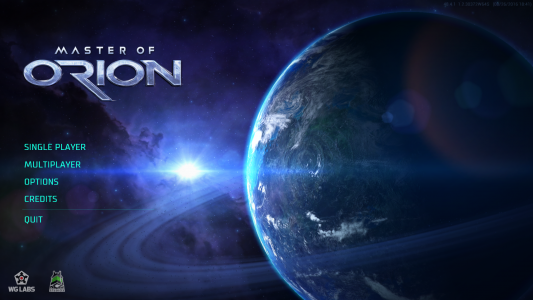
Presentation
First off, the game is gorgeous. From the opening screen, the visuals are crisp and clean, the UI is uncluttered and easy to understand, and the presentation is just great. There are some minor quibbles and tweaks I could wish for, of course. One would be the ability to set complex technology research plans by holding down the shift key, like in Civ 5. That, however, is a minor thing, as I’ve said, and doesn’t detract in any way from the visuals of the game.
The voice-work in the game is a little less universally-wonderful to behold. Make no mistake, the cast is stellar, literally. Michael Dorn headlines the voice team, handling the narration and the ‘This is GNN’ voiceover, along with a host of established, top-flight talent, including Alan Tudyk, John de Lancie, Dwight Schultz, Kari Walghren, Fred Tatasciore, Robert Englund, and the incomparable Mark Hamill. The voice actors have done their jobs well, and turned in stellar performances all around. Those performances could definitely have benefited from improved material, however, as much of the diplomatic dialogue becomes quickly repetitive, and some of the advisors (I’m looking at you, Cooperator Moldred of the Psilons) simply cannot have been intended to be this annoying.
Getting Started
Starting a new game, the first decision is race selection. Each of the original ten races from the first game are present, and for those who purchase the Collector’s Edition, an eleventh race is included: the Terran Khanate. The Khans are in most ways a darker reflection of the Human race, and represent a more militaristic view of humanity’s potential development. Originating in the Alpha Ceti system, the Terrans can exist side-by-side in any game with the Humans, who begin in Sol.
For those new to the franchise, the eleven races (and their bonuses) are:
- Alkari: An avian race, the Alkari Flock begin on Altair, a Large planet with ancient artifacts that provide a bonus to research conducted there. The Alkari are natural pilots, getting bonuses to beam weapon attack and defense, as well as improved speed in their ships.
- Bulrathi: The bearlike Bulrathi come from the planet Ursa, a Large world with high gravity and a rich mineral supply that improves the productivity of industry on the planet. A hardy race, the Bulrathi have an improved tolerance to planetary pollution, and are exceptional at planetary combat.
- Darlok: The Darlok of the planet Nazin are a race of shapeshifters. This gives them the ability to blend into the populations of other races they encounter. As a result of their ability to mingle with the population, their spies are harder to catch, their diplomacy begins with an early advantage, and they are more successful at assimilating conquered populations.
- Human: Humanity is represented in Master of Orion as idealistic and outgoing. This grants them bonuses in diplomacy and trade, but comes at the cost of a greater vulnerability to enemy espionage.
- Klackon: The insectoid Klackons come from Kholdan, an arid world with extensive cavern networks. They are industrious, gaining bonuses to production and food growth, but the hive mind suffers penalties in their research and innovation.
- Meklar: A collective of Artificial Intelligences, the Meklar require less food than other races, allowing them to devote more of their population to industry. They also gain an immediate bonus to the productivity of each worker, making for a potent combination.
- Mrrshan: The feline Mrrshan are a proud, warlike race of hunters. They are skilled negotiators, and have improved ground combat abilities, as well as training ground troops faster, and maintaining more of them in their garrisons.
- Psilon: The classic ‘grey aliens’, the Psilons originate on Mentat, a small world with low gravity and many relics of ancient spacefaring races. Their society’s emphasis on learning and exchange of information leaves them open to outside espionage, but produces an incredibly innovative rate of accelerated research.
- Sakkra: The Sakkra Brood are a reptilian race. Though they suffer penalties in diplomacy and research, their initial technological advantage in industrial and agricultural production fits well with their far higher rate of population growth to allow them to expand quickly and consolidate their strength.
- Silicoid: Silicon-based life forms, the Silicoid originate on the Huge planet Cryslon. They suffer no ill-effects from either high or low gravity worlds, and consume no food, making them able to make excellent use of even the most marginal biomes. This greatly offsets their significant penalties in diplomacy and trade.
- Terran: The Terran Khanate are the other side of humanity’s coin. Starting on the planet of Alpha Ceti, the Terrans avoided self-annihilation through unification under the strong central leaderships of dominating military commanders. They get improved population morale and starship beam attack ratings, train ground troops and build starships at an accelerated rate, and can field a greater number of ships than most races. Their ships are identical to the ships used by the Humans, but present a red paint scheme to the Humans’ blue.
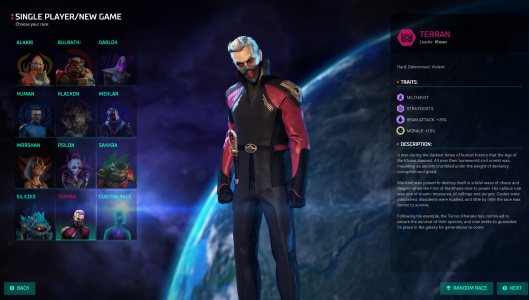
The Khan of the Terran Empire, voiced by Robert Englund. That’s right, the ruler of a race named after a Star Trek villain, wearing the Sith rebreather, is voiced by Freddy Krueger. I’m sure he’s a nice guy.
The final entry in the race selection menu is ‘Custom Race’, where players can mix-and-match, selecting the specific package of traits they want to put together. This is the only one of the MoO II racial additions that’s made it into the new MoO, but DLC, modding, and continued development make it unlikely that it will remain that way. Racial selection (and the basic ‘racial type’ selected in the Custom Race menu) determine the player’s flag color and ship models, as well as the advisor you’ll interact with at many points of the game.
Once you have your race selected, the next step is selecting the game conditions you’ll play under. Galaxy Type – Circle, Spiral, or Cluster – determines the layout of star systems around the galaxy, and the warp routes that connect them. Size ranges from Small to Huge, and determines the number of star systems, and maximum number of races in the game. Small (available only in Circle galaxies) maps can support up to 4 races, and Medium and Large galaxies can have up to 6, while Huge galaxies can support up to 8 (including you). Other settings determine the beginning technological level (Starting Age) and relative levels of biologically-welcoming worlds (Galaxy Age), as well as the pace of the game, number of opponents, and overall difficulty.

Welcome to Space
When the game begins, you’ll be looking at your home star system, with a popup from your advisor. The advisor is the game’s tutorial assistant, and a way to keep an eye out for critical problems. You can disable to advisor, but especially at first, it’s recommended that you keep them around to watch out for problems you might miss – like pollution levels.
This is the galaxy screen. It provides a navigatable map of the galaxy, and the ability to inspect each star system you’ve discovered. The initial system displayed will, of course, be your home system. By hovering your mouse over your homeworld, you can get a quick look at its characteristics. This is true of every planet, once you explore them. Unexplored planets in systems you’ve discovered will be darkened (as the other planet that usually inhabits your home system is, at first). Sending a ship to explore that planet will reveal it, and enable a similar mouseover overview.
Dotted lines connect each star system to at least one other. These are the warp paths that lead out to the greater galaxy. Warp paths that show in red require the discovery of specialized technology to traverse. This is a departure from the approach used in the early games in the series, where ships had a limited range, and were only able to travel a certain distance from an active colony.
Clicking on a colony brings up the command screen for that colony. This shows complete information on that colony’s production and performance, as well as population assignments. This should be immediately familiar to returning fans of the series, and the presentation in this iteration has retained the intuitive, easy-to-understand nature of earlier titles.
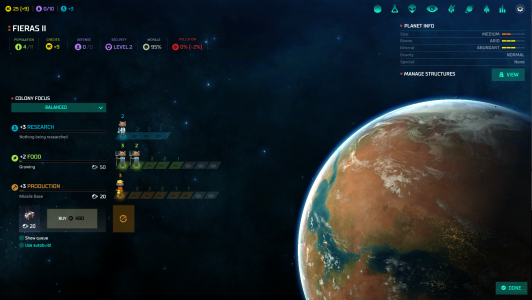
Whenever I play the Mrrshan, I find myself thinking that construction-Mrrshan just looks so depressed. It’s the ears.
The research interface offers a quick, simply selection of currently-available research options, as well as the ability to open up the technology tree. As in most games of this nature, mousing over a technology will bring up a more detailed description of what that technology offers, and long-term planning can be done by selecting a technology deeper into the tech tree. Unfortunately, at this time only one ‘goal’ technology can be selected at a time, and the order of research on earlier, contributing branches is left to the game’s prioritization.
Ultimately, the purpose of technology and research in any 4X game is to build stuff. In the Civ series, where the emphasis and variation is on the cities themselves, this means buildings and wonders. In Master of Orion, as in most 4X Space games, the real goal is designing and building the powerful starships that ply the starlanes.
Ships and Combat
Ships, of course, are the things that let you explore (scouts), colonize new worlds (colony ships, natch), move population and marines around (transports), and do construction work in space (space factories), and most importantly… blow one another to little bits. So it’s important not just to design them well, but to make designing them interesting and accessible. On that front, Master of Orion succeeds.
The ship design screen lists your existing ship designs on the left, and the capabilities of the selected design on the right. In the middle is an image of the hull type you’ve selected, as well as the loadout for that design. Ship equipment comes in 3 types: core systems (engines, armor, computer, and shields), weapons (you know, the things you blow people up with), and specials.
Specials add cetain effects or bonuses to a ship design, such as increased hit points, auto-repair between battles, or additional space to cram more options into. The right set of special modules can take a decent design and turn it into a real killer, while poor selections can wind up unused, taking up valuable space for no gain.
Weapons come in fives basic varieties: beam/energy weapons, bombs, fighters, missiles, and torpedoes. Bombs are useful for destroying planetary structures, ground forces, and civilian populations, but are also used to destroy space-borne structures that are incapable of defending themselves, and pirate bases. Beam weapons, missiles, and torpedoes all have the potential to be upgraded with modificiations such as auto-fire (for beam weapons), multiple warheads (missiles) or overloaded payloads (torpedoes). Applying modifications alters the size, and cost of a weapons system, in addition to the direct performance changes of the modification itself. Fighters (and their successive improvements, Bombers and Heavy Fighters) do not have weapon modifications available, but always carry the latest versions of the weapon types available to them. Additionally, beam weapons and torpedoes have firing arcs, which can be set to forward (default), aft, broadsides, or all. Selecting broadsides or all increases the size and cost of the weapon, similar to the effect of a weapon modification.
The number of slots available for different weapon systems and specials is determined by hull size, and is different from the amount of space a hull has. A frigate, for example, has only three weapon slots, but enough room for more than three missiles. There are six different hull sizes; frigate, destroyer, cruiser, battleship, titan, and doom star, with two different hull options for the first five, and four different paint schemes for each hull. While it’s not nearly as many different ship models as the older games boasted, battles in the new MoO don’t seem likely to involve over hundreds of titans the way MoO II often did.
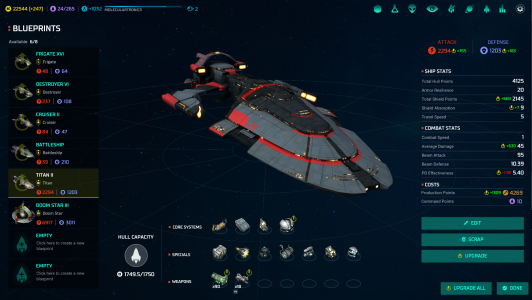
Titans get up to 6 weapon slots, but when you can cram 90 Gauss Cannons onto a single hardpoint, why wouldn’t you?
Combat in Master of Orion is one of the places where I definitely feel there’s room to improve. There are three combat ‘modes’, though all three are essentially the same system. At one end of the spectrum is the cinematic combat, where the AI runs both sides of the fight, letting you watch your ships as they engage their opponants. At the other is full manual control – which is exactly what it sounds like. Between the two is an AI-assisted mode that allows you to give orders to your ships exactly as you would under manual control, but which also provides AI assistance. An example of this AI assistance comes when you order your ships to attack another vessel. Under manual control, your ships move into their engagement range, and begin firing. At this point, they stop moving. With AI assistance, the AI keeps your ships moving, which can help them avoid enemy fire and reduce incoming damage. AI assistance can be toggled on and off at any time during a combat by clicking a fairly inobtrusive button in the upper left of the screen.
Like the classic offerings in the franchise, combat takes place on a two-dimensional plane, with fleets beginning drawn up into battle lines. The defaul camera position looks down on the battlefield from directly above the center, but the camera can be moved around the field and even lowered in angle to view the battle almost horizontally. Different weapons have different ranges, smaller ships tend to move faster, etc. Unlike the older games, however, combat takes place in realtime, which provides a very different feel to the maneuvering options available to a fleet. That doesn’t make it a bad choice, only a different one.
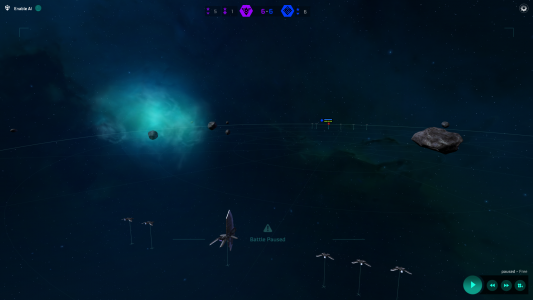
A view of the battlefield from behind a Darlok fleet. That’s the bad guys in distance.
The difficulties come in with the combat UI. Ships are selected either by clicking on an individual ship, or selecting a group by dragging across a section of the battlefield. From there, different speed, engagement range, and formation options present themselves. Movement and firing orders are given by right-clicking in space, and the entire operation is intuitive and will be familiar to any fans of the RTS genre. Unfortunately, selecting a specific enemy target only becomes possible if that target is not in a group of other ships of the same design. If, for example, your enemy has three destroyers on the field, and two of them are identical older designs while the third is a newer, but visually identical ship, it’s possible to target the single vessel, or the group of two. You cannot order your ships to target one specific ship out of the pair, in order to focus fire.
Additionally, engagement options can be forgotten when a waypoint or target is selected. Weapon engagement ranges reset to default, formation orders are lost, etc. It doesn’t happen every time, which in some ways makes it worse. Still, even with these relatively minor, but annoying, weak points, the combat definitely feels more like an RTS version of Master of Orion than those blasted little triangles in MoO III.
Diplomacy
The diplomacy offerings in Master of Orion are pretty standard. Establish embassies, share maps, technology, set up trade treaties, and so forth. Each of the different races has their own flavor of diplomacy, and different thresholds of how tolerant they are to a bad deal, or how pushy they get about their own demands. Ultimately, though, this is one aspect of the game where there just wasn’t much of anything to improve upon from the standard 4X Space diplomacy the first Master of Orion established 23 years ago. The voice acting is nice, but it can quickly become repetitive enough that you just skip over it.
The Takeaway
Overall, the new Master of Orion is a decent entry into the 4X Space genre. A solid game, it hits all the targets reasonably well, even if there’s room for improvement in a number of small ways. Fans of the franchise will find a lot of familiar ground, and enough changes to prevent Master of Orion from being just another retread.
While it doesn’t fill the groundbreaking boots of the first two entries in the franchise, after two decades of genre saturation, that’s pretty clearly an impossible task to expect of any game. What it does do, however, is restore the franchise to active development, and gives the fans plenty to look forward to. Developer NGD has committed to keeping the game’s development cycle going, and we can expect to see the return of some features, like minor races, that were deemed not yet ready for prime time during early release. Additionally, with a similar commitment to making the game accessible to the modding community, NGD and Wargaming look to be setting the stage for what will undoubtedly be an explosion of new content and options.
This new offering has also firmly established Wargaming as more than just ‘the World of Tanks guys’. With Master of Orion back on firm footing, and both the Total Annihilation franchise and its creator, Chris Taylor, under their wing, we can surely expect to see more games coming out of WG Labs in the future.
This article originally appeared on TheMittani.com, written by Arrendis.

